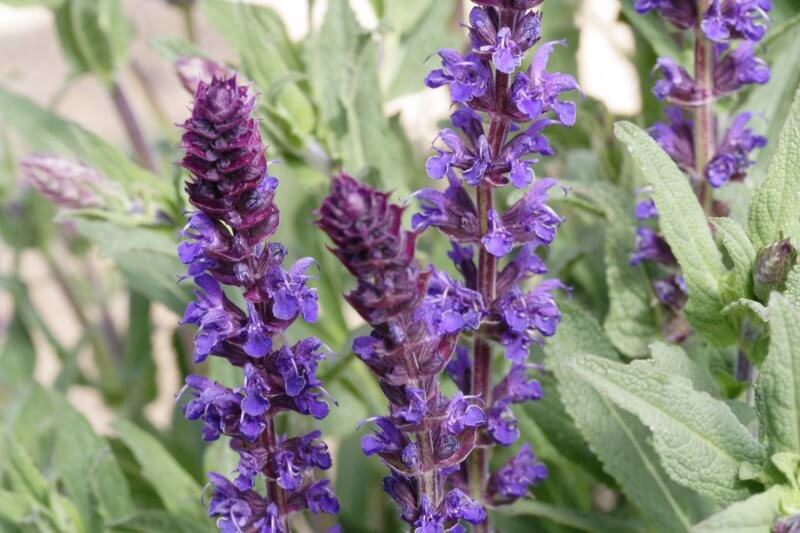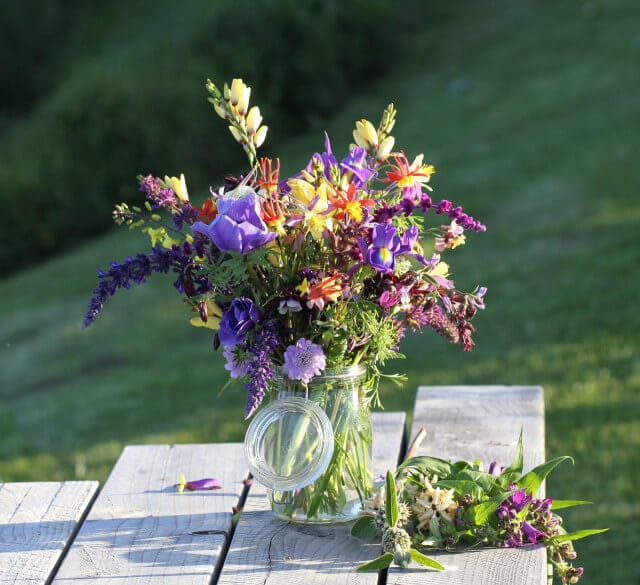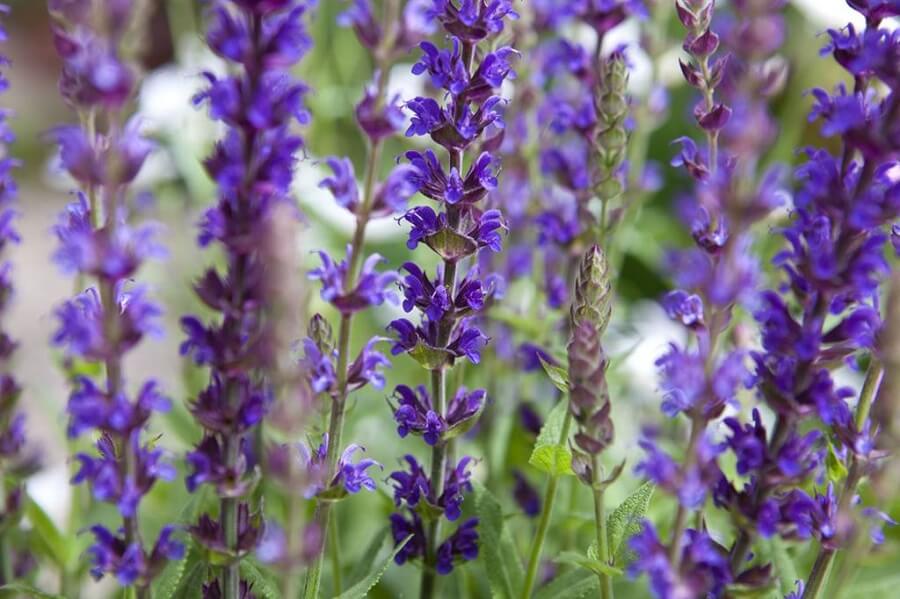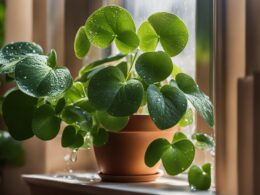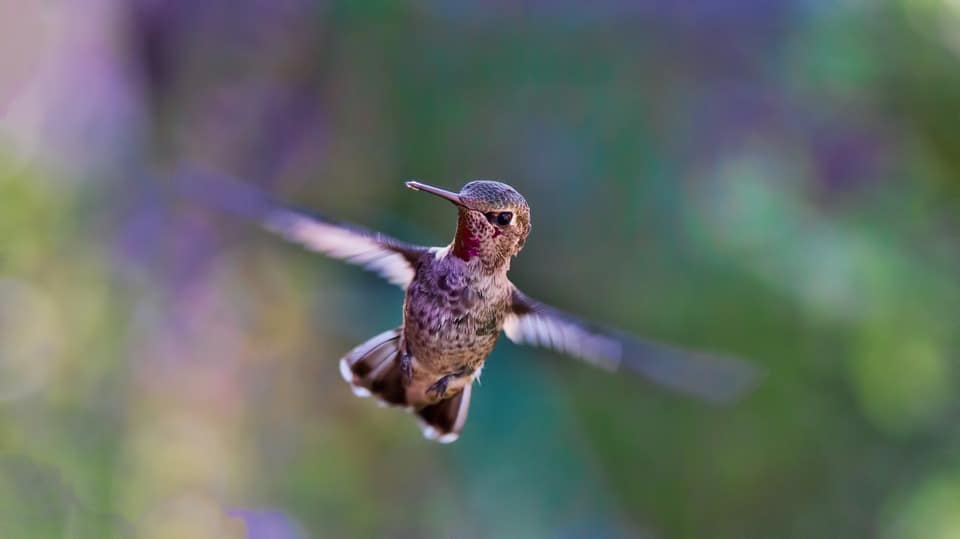Salvia nemorosa is one of the easiest perennials to grow, and one of the prettiest as well. Also known under the name of Balkan clary ‘Caradonna’, the salvia nemorosa is part of the Lamiaceae family, and sports upright purple flowers that are impossible to miss. Even if growing salvia nemorosa is not at all a difficult task, there are some things that you should keep in mind if you want to plant this type of perennial in your garden or backyard. That’s why we decided to make today’s guide all about some tips and tricks on how to grow salvia nemorosa successfully. Let’s have a look, shall we?
Salvia Nemorosa Growing Guide: 10 Useful Tips
1. Plant Overview
The first thing that you should do before planting anything in your garden is research the plants and see what their general characteristics are and what they prefer. For instance, in the case of salvia nemorosa, it reaches a height of between 1 and 3 feet, and an equal spread. It doesn’t take a long time to grow and develop, but also don’t expect it to grow overnight. It grows in clumps that sport showy flowers and a fragrant foliage that attracts butterflies.
In terms of growing conditions, unlike other perennials, this one can only stand full sun, so make sure you plant it in a place that gets a lot of sun exposure. It also grows best when the soil is not extremely moist, but in between dry and medium. If the plants develop as they should, you’ll be able to enjoy their blooms all throughout summer.
One of the main reasons why people choose to grow salvia nemorosa is that it has a lot of uses. You can use it in garden beds, garden borders, as ground cover, as cut flowers, and even dry its blooms and decorate your home with them. Salvia nemorosa isn’t only low-maintenance, it’s also extremely tolerant to drought and pests.
Another thing that we must mention is the fact that the purple flowers of the salvia nemorosa create a lovely contrast with its purple-black stems. This combination makes the flowers seem like they have two different shades of purple to them.
2. Growing Conditions
As in the case of any other plant, the salvia nemorosa also has certain growing conditions under which it develops best. Among the most important ones is the exposure to full sun that we’ve already mentioned. Then, the quality of the soil is also relevant. The best possible soil in which to grow it has to be well-drained and preferably sandy for best results. Even so, chalky and clay soil are two other options that work as well. The soil’s pH is another factor that you should keep in mind. Here, the options allow for a very large range of growing conditions, since the pH can be neutral, alkaline, or acid.
3. Plant Cultivation
You can plant salvia nemorosa either from seeds or from an already established plant. The first option is better for people who’ve never grown this plant before. Still, it can be more difficult to grow salvia nemorosa from seeds than from an actual plant. Which is why the best option is to purchase a plant and then transplant it to your garden. Regardless of the cultivation technique you decide to go with, the best time to plant the seeds/seedlings is in late spring, at a depth of 1/8 inches and a distance of 24 to 30 inches from one another.
4. Soil Care
Even if your soil is perfect for growing salvia nemorosa, that doesn’t mean that you can’t help it become an even better host for your plants. For instance, if you have clay soil, you can mix it with organic matter and sand. This will improve its drainage capacity and make it lighter.
5. Watering Habits
As we’ve already mentioned, salvia nemorosa doesn’t do well when watered excessively. This is especially true when the plants are small. During that time, it’s enough for you to carefully mist them so that the soil stays moist. When the plants develop to their full potential, watering them is only a necessity when you notice that the soil is completely dry. The frequency with which you water your plants also depends on the climate of the area where you live. For example, if you live in a place where you get regular rainfall, you don’t even have to worry about watering your plants yourself. The rainfall water is more than enough.
6. Growing Salvia Nemorosa Indoors
Salvia nemorosa can be easily grown in containers indoors. The only thing that you should keep in mind when it comes to this alternative is that you might experience some issues regarding sun exposure. If you can’t provide your plants with as much sunlight as they would get if grown outside, then you have to think of another solution. We recommend purchasing fluorescent lamps and use them as a replacement for natural light. Be careful not to keep them too close to the plants. A distance of 2 to 4 inches is enough.
7. Salvia Nemorosa Pruning
Pruning is an important step in growing salvia nemorosa, but it’s a fairly easy one, so you don’t have to worry too much about it. The best time to prune is in early spring. That’s because you have to find the perfect period in between the last frost and the time when new growths begin to appear. In order to make sure you’ve thoroughly pruned your plants, you should take each stem at a time and cut it about a third. Do this only if the stems are older and visibly woodier.
8. Controlling Pests
The first thing that we should mention is that salvia nemorosa isn’t really affected by pests, except very rarely. Since this can happen to anyone, it’s better to know what to do beforehand. The most common pests that you might encounter when growing this type of plant are Spittlebugs, mites, and thrips. The best way to get rid of all of these is by using an organic pesticide. Another option would be to use insecticidal soap.
9. Keeping Away Mildew
If pests like the ones we mentioned above are not so common, mildew is something that more people have to deal with when growing salvia nemorosa. Luckily, there are things that you can do to prevent mildew from affecting your plants. Since the optimum environment for mildew is humidity, we advise you to closely supervise your plants when the weather is particularly humid and hot. Moreover, you should provide them with good air circulation by thinning them every now and then.
The earth around the plants is also important when it comes to mildew prevention. You can add pebbles to it since they’ll help the area get rid of excessive moisture faster. Sometimes, even if you’ve done everything you could to prevent mildew, your plants can still become affected by it. If this happens, purchase a sulfur spray or some horticultural oil and spritz them with it.
10. Replacing the Plant
As much as you focus on salvia nemorosa care, after a couple of years, they’ll become too straggly and woody. This usually happens about 3 to 5 years after you’ve planted them. When you notice this, it means it’s time to replace your plants. Here, you have two options. The first one is to use cuttings or layering from the old plant. The second one is to purchase new seeds and start everything all over again.
If you decide to go with the first option, here’s what you should know. When you use layering, you have to take a branch of an existing plant and bend it until it reaches the ground. Then, take a wire and pin it to the ground. You’ll notice that in approximately 4 weeks, you’ll be able to see new roots. Feel free to then take the new plant out and move it to a different location.
If you want to use cuttings, 3 inches of a branch is enough to get a new plant to grow. Make sure the stem doesn’t have any leaves in the lower part, then dip its end in rooting hormone. After 4 to 6 weeks of sitting in sterile sand, the new plant should be ready for you to transplant to a different place.
Summing It All Up
No matter whether you have a large garden or you simply like to grow flowers in containers indoors, the salvia nemorosa plant can become one of the most attractive additions to your household. It offers all the benefits you could wish for in a perennial, from low-maintenance to very few obligatory care rituals, a lovely shade, fragrant foliage, little to no pests, and many others.
Thus, if you’re looking for a plant that will provide your garden or home with a touch of color, without you having to look after it constantly, we entirely recommend the salvia nemorosa. Very few plants are as easy to grow and eye-catching as this one, and that’s something you’ll be made aware of the instant your plants start to develop.





